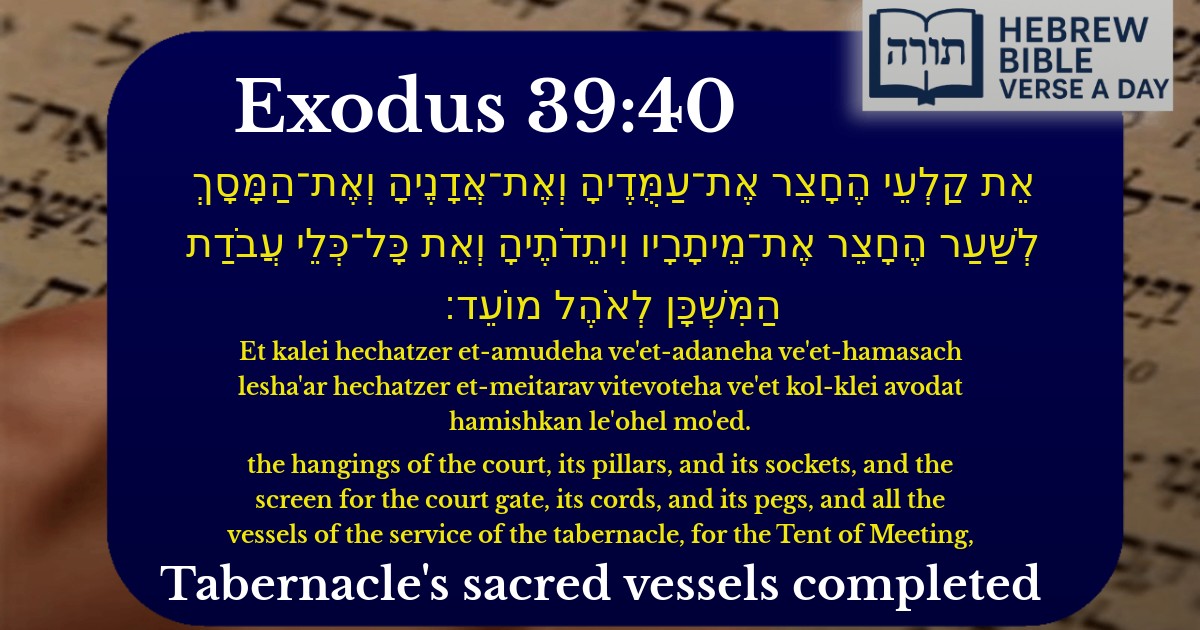Join Our Newsletter To Be Informed When New Videos Are Posted
Join the thousands of fellow Studends who rely on our videos to learn how to read the bible in Hebrew for free!
Hebrew Text
אֵת קַלְעֵי הֶחָצֵר אֶת־עַמֻּדֶיהָ וְאֶת־אֲדָנֶיהָ וְאֶת־הַמָּסָךְ לְשַׁעַר הֶחָצֵר אֶת־מֵיתָרָיו וִיתֵדֹתֶיהָ וְאֵת כָּל־כְּלֵי עֲבֹדַת הַמִּשְׁכָּן לְאֹהֶל מוֹעֵד׃
English Translation
the hangings of the court, its pillars, and its sockets, and the screen for the court gate, its cords, and its pegs, and all the vessels of the service of the tabernacle, for the Tent of Meeting,
Transliteration
Et kalei hechatzer et-amudeha ve'et-adaneha ve'et-hamasach lesha'ar hechatzer et-meitarav vitevoteha ve'et kol-klei avodat hamishkan le'ohel mo'ed.
Hebrew Leining Text
אֵת֩ קַלְעֵ֨י הֶחָצֵ֜ר אֶת־עַמֻּדֶ֣יהָ וְאֶת־אֲדָנֶ֗יהָ וְאֶת־הַמָּסָךְ֙ לְשַׁ֣עַר הֶֽחָצֵ֔ר אֶת־מֵיתָרָ֖יו וִיתֵדֹתֶ֑יהָ וְאֵ֗ת כׇּל־כְּלֵ֛י עֲבֹדַ֥ת הַמִּשְׁכָּ֖ן לְאֹ֥הֶל מוֹעֵֽד׃
Parasha Commentary
📚 Talmud Citations
This verse is not quoted in the Talmud.


Overview of the Verse
The verse (Exodus 39:40) enumerates the components of the Mishkan (Tabernacle) and its courtyard, detailing the hangings, pillars, sockets, screen, cords, pegs, and vessels used in its service. This list reflects the meticulous attention given to every element of the Mishkan, as each item had a specific purpose in facilitating the Divine service.
Rashi's Commentary
Rashi (Exodus 39:40) emphasizes that this verse serves as a summary of all the materials and components brought by the Israelites for the construction of the Mishkan. He notes that the phrase "all the vessels of the service of the tabernacle" includes the smaller utensils used in the daily rituals, such as basins, forks, and fire pans, underscoring that nothing was overlooked in the preparation of the sacred space.
Rambam's Perspective
In Hilchot Beit HaBechirah (Laws of the Chosen House), Rambam (Maimonides) discusses the significance of the Mishkan's structure as a precursor to the Beit HaMikdash (Holy Temple). The detailed enumeration of the courtyard's components highlights the importance of creating a designated, sanctified area for Divine worship, a principle that carries forward into the construction of the Temple.
Midrashic Insights
The Midrash Tanchuma (Pekudei 7) draws a parallel between the Mishkan's components and the universe itself, suggesting that the hangings ("קַלְעֵי הֶחָצֵר") symbolize the firmament, while the pillars ("עַמֻּדֶיהָ") represent the foundational elements of creation. This teaches that the Mishkan was a microcosm of the world, reflecting the harmony between physical and spiritual realms.
Symbolism of the Components
Practical Lessons
The verse reminds us that every detail in avodat Hashem (Divine service) matters. Just as the Mishkan required precision in its construction, our spiritual lives demand attention to both major obligations and seemingly minor acts of devotion (based on the teachings of the Chofetz Chaim).